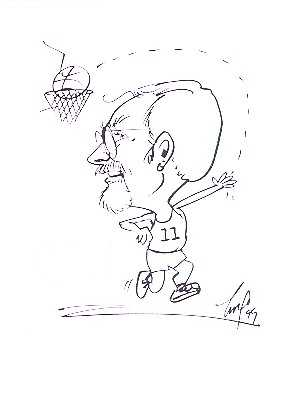The Lay-Up line
Been awhile since I last posted here; basically, I haven't played at all for the last two months (except for an occasional half-hour of shooting on my own at the gym). Vacation, then a busy work schedule, and now some strange injury which I can't really attribute to any specific incident, but which has me limping around on a tender right knee with sympathetic pain in my hip, back, and the large muscles of my right leg, have pretty much kept me off the court. But organized play at my regular gym started up again last Sunday, and really gets going in earnest a week from tomorrow. Of course, we'll all be a little rusty coming back from the long summer lay-off. So it will be a challenge to see how quickly I can work myself back into game shape.
Here's a (relatively) simple lay-up drill that reinforces many of the fundamentals of a good half-court motion offense:
• Player 1 begins at the point.
• Players 2 & 3 begin at the opposite wings.
• Player 4 begins at the elbow (in a high post postion).
"1" makes a good chest pass to 3 and replaces 2 opposite.
"2" drops down to the weakside low block (the "wormhole") to rebound.
"3" passes to 4 at the post, and cuts back-door to the basket.
"4" makes a return bounce pass to 3 for the lay-up.
2 rebounds the ball, pivots to the outside, and outlets with a good overhead pass to 1 (now "2"), then replaces "3" on the opposite wing.
1 (now "2") reverses the ball to 4 (who has replaced "1") at the point.
4 (now "1") reverses the ball to 2 (now "3") at the wing.
2 (now "3") makes the entry pass to 3 (now "4") at the high post elbow...
and the entire pattern repeats again.
Here are some variations.
• Allow the player at the point to pass the ball to EITHER wing. The wing player WITHOUT the ball now becomes a defender as well as a rebounder.
• With more than four players, those waiting to enter the drill should line up along the sidelines on both sides of the court. Those entering the drill on the "ball" side should replace the player at the wing; those entering on the "help" side should replace the player at the point. The Post Player ("4") now becomes a second rebounder, and BOTH rebounders ("2" and "4") should exit the court at the baseline and return to the end(s) of the line(s) of waiting players. Player "1" still "screens away" from the pass; player "3" still flashes to the high post after shooting.

